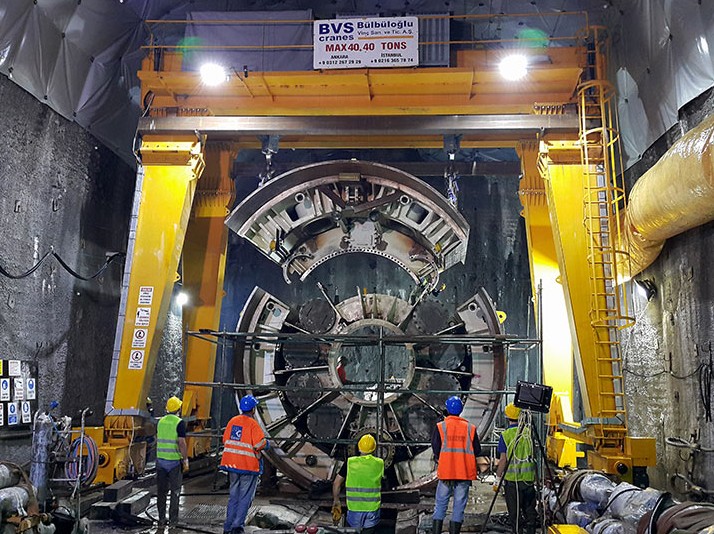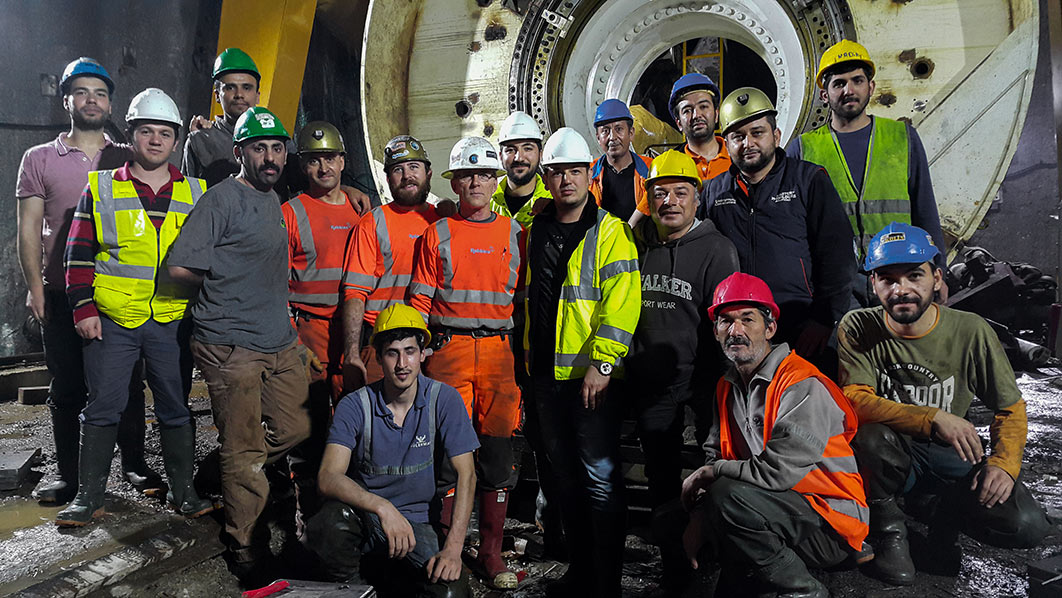XRE TBM conquers toughest drive in Turkey 21 Feb 2019

OFTA assembly of the TBM more than 7km into the tunnel drive that defeated a different supplier’s double shield TBM
A 5.56m diameter Robbins XRE Crossover TBM has completed excavation of the longest water tunnel in Turkey overcoming dozens of major fault zones and water pressures up to 26 bar along the way. Contractor JV of Kolin/Limak started excavation of the 31.6km long Gerede water transmission tunnel using three double shield TBMs supplied by another manufacturer. The Robbins XRE TBM was called in to complete the project, which was at a standstill when the three initial machines encountered incredibly difficult geology including massive inrushes of mud and water. The 9km long final leg of the tunnel, through extremely difficult sandstone agglomerate, limestone and tuff, is widely considered to be the most challenging ever excavated by TBM in Turkey.
“I have had the chance to study and visit the majority of mechanized tunnelling projects in Turkey since the 1980s and the Gerede project is one of the most challenging projects among them,” said Dr Nuh Bilgin, Professor of Mine and Tunnel Mechanization at Istanbul Technical University and Chairman of the Turkish Tunnelling Society.
Gerede water tunnel project data
- The 5.56m Robbins Crossover XRE TBM navigated 48 fault zones and water ingress pressures of up to 26 bar
- Robbins Crossover machine completed tunneling on December 18, 2018, finishing the final leg of the Gerede water transmission tunnel.
- The Robbins machine was launched more than 7km from the tunnel portal and worked through difficult ground that brought two double shield TBMs from another manufacturer to a halt
The Kolin/Limak JV had to develop a new strategy given the unexpected ground conditions. It contacted engineers at The Robbins Company, who suggested a Crossover dual-mode type TBM for the remaining section of tunnel. “The Crossover TBM provided ease and versatility to drive through the frequently changing ground conditions,” said Barış Duman, Project Manager for the Kolin-Limak JV. “The TBM was equipped with features such as increased thrust, two-speed gearboxes, and a modular screw conveyor. It was capable of giving the necessary responses in different geologies, which was our most important asset in achieving our goal.”
“The challenging part for us was to design and manufacture a TBM that could complete the difficult section of the Gerede Tunnel where two other competitor TBMs had failed,” said Yunus Alpagut, the Robbins representative in Turkey. The specialized machine was designed to statically hold water pressure up to 20 bar - a failsafe that none of the standard double shield TBMs had been equipped with. The machine was also fitted with a convertible cutterhead that was designed for ease of conversion between hard rock and EPB modes, and with cutter housings that could be fitted with either disc cutters or tungsten carbide tooling. To cope with difficult ground, the Gerede TBM was also equipped with the torque-shift system, multi-speed gearing allowing the machine to function as either an EPB or a hard rock TBM. This function is activated by adding another gear reduction - heavy duty pinions and bull gears accommodate high torque at low speed, allowing the machine to bore through fault zones and soft ground without becoming stuck.
The Crossover machine was delivered to Turkey and assembled in Spring 2016 after crews excavated a bypass tunnel to one side of one of the stuck double shield TBMs. An underground assembly chamber allowed the machine to be built in the tunnel using onsite first time assembly (OFTA). “The logistics of getting components through the existing tunnel was a challenging process,” said Glen Maynard, Robbins Field Service Site Manager. “The assembly chamber was 7km from the portal and water inflows of up to 600 lt/sec (159 gal/sec) made it difficult to get the materials to the machine.”
Despite the challenges, the machine began boring in Summer 2016 and within the first 50m of boring had successfully passed through the section that had buried the original double shield TBM. The Robbins XRE machine was required to be used in EPB mode as it encountered water pressures of up to 26 bar, alluvium, flowing materials, clay and a total of 48 fault zones. Water pressure was lowered by draining the ground water through the rear shield probe drill ports, which were equipped with normally-closed ball valves. Probe drilling was undertaken on a routine basis to get through the ground conditions. “Together with the difficult geological conditions, the travel time to reach the TBM through the previously completed tunnel had effects on TBM performance,” said Duman. “Nonetheless, tunnel excavation achieved a best day of 29.4m, a best week of 134.6m and a best month of 484m (1,588ft).”
“We had many challenging areas with high volume water ingress and under high pressures of up to 26 bar, along with alluvial material in fault zones,” continued Duman. “Ground pressure on the shield body caused squeezing conditions in clay. In these reaches, we were able to quickly pass through by keeping the TBM advance rate, cutterhead rev/min and screw conveyor rotation speeds at the ideal level. Ultimately, we think our decision to select a Crossover TBM was correct.”
With tunneling complete, the pipeline is on track to open in March 2019. The tunnel is an urgently needed project due to severe and chronic droughts in the capital city Ankara, and will convey water from the Gerede River to the Çamlıdere Dam, which provides potable water for the Ankara city water system.
References
- Crossover TBMs bridge the gap for Robbins – TunnelTalk, March 2015
- Mexico City XRE TBM finishes on a high note – TunnelTalk, July 2017
- Crossover TBM powers through in Akron – TunnelTalk, September 2018
- Flexibility key to battling poor geology in Turkey – TunnelTalk, July 2014
- North American debut for new-design TBM – TunnelTalk, June 2014
- Tackling fault zones in the mountains of Turkey – TunnelTalk, January 2014
|
|
|
|
|
Add your comment
- Thank you for taking the time to share your thoughts and comments. You share in the wider tunnelling community, so please keep your comments smart and civil. Don't attack other readers personally, and keep your language professional.





